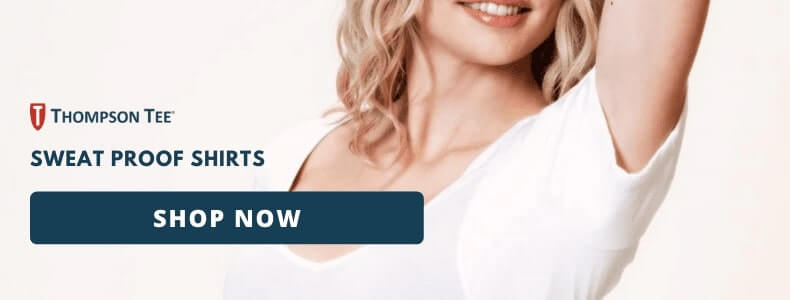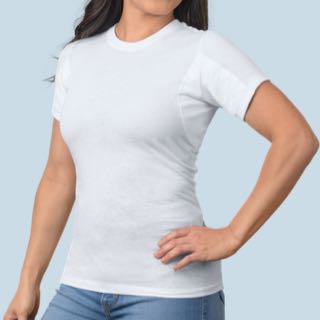8 Sweat-Resistant and Sweat-Absorbing Fabrics Explained
Finding a quality shirt that prevents sweat is like striking gold. Not to mention brands often use language like “sweat resistant,” “sweat absorbing,” “sweat wicking” or “moisture wicking” to describe the fabric, which can confuse buyers.
In this blog, we’ll teach you how to be a savvy shopper and pick out the best sweat-blocking materials before making a purchase.
TYPES OF SWEAT-BLOCKING MATERIALS
Let’s break down examples of different sweat-absorbing fabrics and sweat-resistant fabrics.
BEST SWEAT-ABSORBING FABRICS
Here are our top choices for sweat-absorbing fabrics:
- Cotton
- Bamboo
- Linen
- Merino wool
Cotton: Quality, lightweight cotton is one of the most breathable fabrics, offering some airflow for drying out any dampness. Because cotton is a natural fiber, it absorbs moisture (drawing it away from your skin) rather than repelling it (forcing the sweat to sit on your skin). Note that with standard cotton shirts, you'll have to be mindful of the colors you choose. Since it absorbs moisture so easily, pit stains can be a problem.
Bamboo: Bamboo is a high-quality, absorbent, breathable and ultra-soft material. It’s also hygienic due to its resistance to odor, mold, mildew and bacteria — even after multiple washes.
Linen: Linen is a natural fiber that is lightweight, breathable and absorbent. It also doesn’t cling to the body, which can keep you cool. However, linen wrinkles easily, so it can be challenging to wear linen for everyday use.
Merino wool: Contrary to popular belief, wool can keep you cool and dry. Merino wool is a natural fiber that draws sweat away from your skin, allowing it to evaporate as vapor. It’s excellent for regulating body temperature and ideal for wearing all year round.
TOP SWEAT-RESISTANT FABRICS
Here are the most popular sweat-resistant and sweat-wicking fabrics on the market:
- Polyester
- Rayon
- Cotton/lycra blend
- Nylon
Polyester: Polyester is durable and water-resistant, but don’t let these words fool you. Polyester doesn’t absorb sweat; in fact, it might make you sweat even more. The moisture sits on your skin or gets pushed to your outer layer — the complete opposite effect you want from a sweat-blocking material.
Rayon: Rayon is lightweight and doesn’t trap heat, but because it’s a synthetic fabric, it repels moisture and doesn’t absorb it (i.e., not a good solution for heavy sweaters).
Cotton/lycra blend: Cotton is an absorbent fabric, but when combined with lycra, the combination traps heat and moisture, creating a breeding ground for sweat, especially when wearing tight clothing.
Nylon: You’ll often find nylon in activewear. However, nylon is 100% synthetic, so it’s an impractical choice for those who sweat heavily. Nylon isn’t breathable and will trap heat and moisture easily, making you sweat more.
Most sweat-resistant and moisture-wicking fabrics are synthetic. Many are even coated with chemical treatments that wear off when washed. In turn, the sweat-resistant or sweat-wicking effects only last a few wears. Sweat-wicking performance materials can also be more expensive.
WHEN TO USE DIFFERENT SWEAT-BLOCKING MATERIALS
Choosing natural or synthetic depends on your sweating needs. Here are some everyday situations where you need sweat-blocking power and the best material for each:
- At work or in a professional setting: Avoid synthetic fabrics and opt for natural sweat-absorbing fabrics. We highly recommend wearing a sweat proof undershirt beneath any dress shirt or professional wear to help manage sweat marks and keep your confidence up. Read more: Professional Clothes for People Who Sweat
- Social situations: For casual settings, choose soft, comfortable fabrics like cotton or linen. Avoid synthetic fabrics, which can retain the smell of sweat and increase your body odor.
- Exercising and working out: It’s okay to wear sweat-wicking or sweat-resistant materials when you’re exercising. Synthetic materials are suitable for workouts because they keep sweat away from your body, producing a cooling effect. However, natural fibers can be just as effective.
THE BEST SWEAT ABSORBING SHIRT FOR ANY SITUATION
When it comes to keeping sweat at bay, sweat-absorbing clothing is the way to go. Natural fabrics are ideal for staying dry and a smarter choice for the environment.
If you’re looking for a shirt that checks off all the boxes and prevents sweat marks and pit stains, look no further than the Thompson Tee’s sweat proof undershirts for men and women.
Here are just a few features of Thompson Tee’s bestselling sweat proof undershirts:
- Made with cotton
- Engineered with patented Hydro-Shield sweat proof technology, so you don’t show sweat ever
- 30-day risk-free guarantee — feel free to wear it and wash it.
Want to see how the Thompson Tee stacks up against other sweat-blocking clothing? Try it risk-free today!




